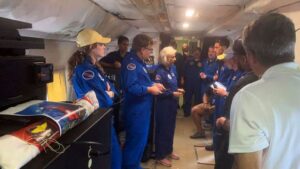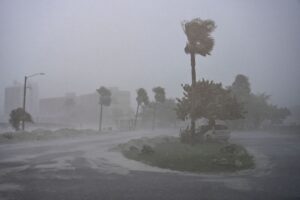
Peter Dodge dedicated his life to gathering data from hurricanes to help improve prediction models to aid in evacuation preparedness
A world-renowned scientist with NOAA has his final wishes fulfilled after his ashes were dropped into Hurricane Milton.
Peter Dodge worked with the National Oceanic and Atmospheric Administration for years flying into nearly 400 hurricanes to gather crucial data from the storms. On Tuesday during a reconnaissance flight into the incoming Hurricane Milton, the NOAA crew dropped Dodge’s ashes into the storm in a lasting tribute to their late colleague.
“It’s very touching,” Dodge’s sister, Shelley Dodge, said in an interview Thursday with The Associated Press. “We knew it was a goal of NOAA to make it happen.”
Hurricane Milton RECAP: Devastating aftermath across Florida – as 13 dead and THREE MILLION without power
Hurricane Milton kills at least 13 as storm leaves devastating trail of destruction across Florida

Dodge was part of a 1989 crew that saw four of their plane's engines catch fire during a flight into Hurricane Hugo. (Image:AFP via Getty Images)
Dodges ashes were released on Tuesday in the eye of the storm, ahead of Miltons eventual landfall on Wednesday on the west coast of Florida.
Dodge passed away in March 2023 after suffering complications from a fall and a stroke. The Miami resident worked for NOAA for 44 years and won numerous awards during his time with the administration, including one for technology that was used to study the destructive winds of Hurricane Katrina.
He was part of a 1989 crew that saw four of their plane’s engines catch fire during a flight into Hurricane Hugo.
“They almost didn’t get out of the eye,” Shelley Dodge said.
A degenerative eye disorder caused Dodge to cease going on reconnaissance flights. His sister says NOAA kept her in the loop regarding when her brothers last flight would be.
“There were various times when they thought all the pieces were going to fall in place but it had to be the right combination, the research flight. All of that had to come together,” she said. “It finally did on the 8th. I didn’t know for sure until they sent me the official printout that showed exactly where it happened in the eye, Shelly Dodge said
Dodge was part of a 1989 crew that saw four of their plane's engines catch fire during a flight into Hurricane Hugo. (Image:AFP via Getty Images)
According to a NOAA newsletter announcing his death, Dodge had extensive experience in radar technology and a keen interest in tropical cyclones.
The newsletter said that Dodges colleagues were “saddened by the sudden and tragic loss of one of its longtime meteorologists.
During hurricane reconnaissance missions Dodge primary served as on onboard radar scientist. He frequently worked with the National Hurricane Center and the Aircraft Operations Center on both airborne and land radar research.
He was the recipient of two NOAA Administrator Awards as well as a Bronze Medel from the Department of Commerce and the Army Corps of Engineers Patriotic Civilian Service Award.
Dodges ashes were placed into a package draped with the flag of Nepal, where he spent time in the Peace Corps teaching math and science to high school students before becoming a meteorologist.
“He just had an intellectual curiosity that was undaunted, even after he lost his sight,” Shelley Dodge said.